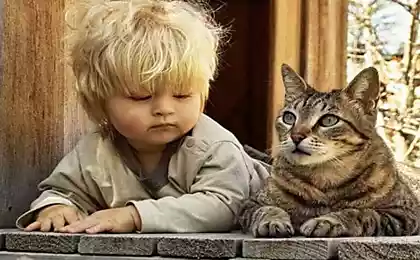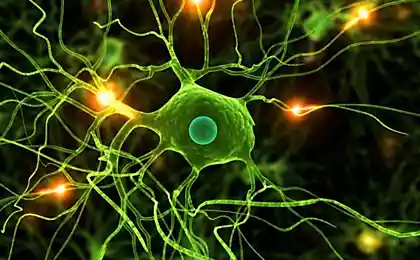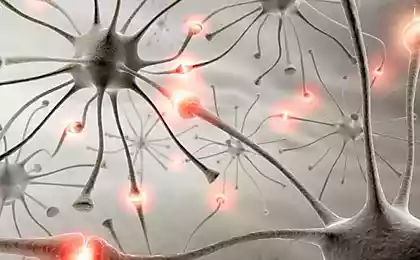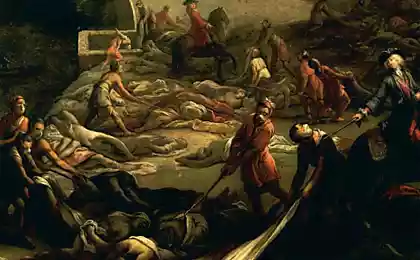544
Paradoxes and phenomena of multiple sclerosis
Multiple sclerosis (MS) is a chronic invalidusername disease received its name due to the presence of multiple scattered through the nervous system tight "knots", which are like scars in the shells of nervous fibers.
The sizes of lesions (plaques) — from millimeters to centimeters, with the progression of the disease they may merge into large pockets. Often one and the same patient find both old and fresh plaque that is considered to be an expression of disease progression.
For PC characterized by a fluctuating course with periods of deterioration and improvement. The duration of the exacerbation can be from a few seconds to weeks, and remission from one month to several years, despite the fact that the destruction of neural tissue is ongoing.

MS is a disease of the young (15-35 years), occurring twice as often in women than in men. However, the latter dominates the progressive form of the disease.
Noted that the RS distribution varied in different regions of the world. The zone of high risk (more than RS 30 cases per 100,000 population) are the regions located above the 30th parallel on all continents (G. Kurtzke, 1980, 1993), i.e. the USA, Canada and Russia. The distribution of incidence increases from South to North.
The cause (etiology), mechanism of development (pathogenesis) of RS is not known. The conventional wisdom that the RS occurs as a result of random combinations of a given person of a number of adverse external and internal factors, which include frequent infections, the impact of toxic substances and radiation, Smoking, eating habits, frequent stressful situations, trauma, etc. it is believed that there is a genetic predisposition to MS, which is associated with the presence of the patient changes in genes responsible for regulation of immunity.
The most common opinion that the PC is an autoimmune disease that is triggered by the virus, or continuing to dwell in the body of the patient (Hit-Hit Theory), or disappeared after infection (Hit-Run Theory). The resulting scars in the shells of the nerves are small hemorrhages — the result of a viral infection.
Of particular interest to the infectious nature of the RS appeared at the end of the XIX century, when doctor Pierre Marie (1884) noted the frequent occurrence of sklerozirovanie "plaques" in nervous tissue after infection. But the dominant viral theory began after the outbreak of the RS, resulting in the epidemic of encephalitis in the 1920-30es. The idea that neurological diseases can have an allergic-inflammatory nature after viral infections or vaccinations were expressed by Dr. Glanzman in 1927.
Indeed, many patients with MS, at the early stage of the disease and with each exacerbation, peripheral blood revealed antibodies to the virus Epstein-Bar (EBV), which may indicate the likely latent infection in which the virus is possibly an activator of indolent inflammatory process caused by other microbes, for example, herpes (HHV-6), polio-, retro -, and coxsackie viruses, chlamydia, spirochete B. burgdorferi, the causative agent of Lyme disease, etc.
Dr. Henry Kempe (Univ. Colorado School of Medicine) believes that RS causes the smallpox virus, obtained by grafting, since antibodies to this virus have been allocated to them from the cerebrospinal fluid of MS patients, who had the destruction of nerve fibers. Many scientists believe the provocateurs of the disease the vaccine against hepatitis b, measles, tetanus etc.
Evidence of microbial theory a lot, and provocateurs development RS are the sinusitis, tonsillitis and infectious mononucleosis caused by EBV, as well as allergies, moved at an early age. For example, sinusitis occurs in MS patients was 53% more likely than the average population. Interestingly, if the PC is constantly progressing disease, concomitant infection due to any circumstances — not (Lai,1996).
Although the incidence of RS is constantly increasing (the phenomenon of the epidemic), RS is a relatively "new" disease, for the first time was only in the mid-nineteenth century. This indicates a possible correlation between the disease and environmental degradation. Today, there are about 2 million MS patients. Most of them live in industrial areas and large cities and at least 5 years living near a chemical production.
Unfortunately, there is no coherent theory of the etiology and pathogenesis of MS, and a considerable number of inconsistencies and paradoxes suggests that the common view of the RS is incomplete and possibly incorrect.
For example, the twin paradox. Although MS tends to meet more often with relatives, at the same time, only 25% of identical twins, whose genes are identical, cheer with RS.
Another paradox — the action of the environment. If the Japanese born in Hawaii, the RS occurs 3 times more often than in Japan, the white Hawaiians 3 times less than whites from California (Kuroiwa et al, 1983; Poser, 1994). Residents of the Canadian Prairies is much more common in RS than their neighbors to the North of Newfoundland. Never get sick of RS, Africans, Eskimos, Australian aborigines.
An interesting phenomenon Faroe Islands, occupied by British troops in 1941-44gg. During this period of RS, rare up to that time the disease in the Islands, at the same time ill a few people, most of them teenagers, have lived near military bases (Kurtzke, 1977, 1980, 1995).
At the same time, children adopted into families where there are sick of the PC, do not hurt the disease (Ebers & al, 1995). No data on the possible transfer of DCS from blood transfusions (Theofilopoulos, 1995).
The so-called "clinical-radiological paradox" of the RS shows the inconsistency of the expression changes in the brain detected by MRI, and clinical manifestations of the disease (Barkhoff, 2002).
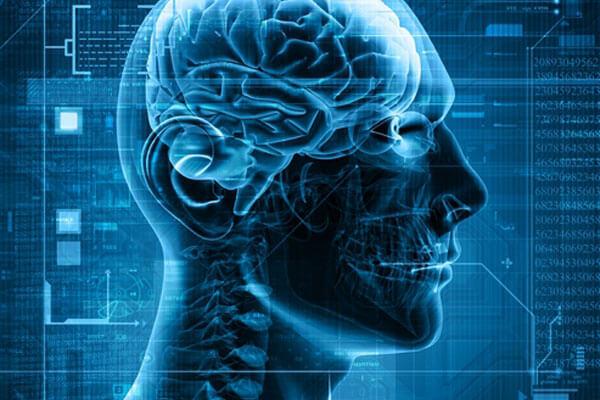
In 50% of cases of focal brain damage detected incidentally and the patient has no symptoms. At the same time, there is a mismatch between the objective neurological symptoms of nerve damage and subjective feelings of the patient that was called the "impermanence syndrome RS" (D. A. Markov, A. L. Leonovich). The frequency of MS exacerbations is not correlated with disease severity, and remission does not prevent disability of the patient (N Engl J Med 2000; 343).
Immune cells, causing the process of nerve damage is not always found in fresh lesions, and in 35% of the plaques there are no signs of inflammation ( Lumsden, 1972).
The therapeutic approach to MS, as an autoimmune-inflammatory disease that have similarities with other similar diseases and, in particular, with allergic, encephalo-myelitis, often does not give the expected result, and in some cases leads to relapse.
These and many other phenomena and paradoxes RS allowed doctors Behan, Chaudhuri and Roep (2002) to conclude that the theory of the pathogenesis of RS is incorrect and that the PC is not an autoimmune disease, and complex metabolic disorders, and the synthesis of hormones that may be genetically modified "soil" and accompanied by the degeneration of the nervous system.
This theory allows, for example, to explain the "geographic paradox": in the Northern latitudes and especially in the industrial areas, people are more likely to suffer from vitamin D, which is characteristic of MS patients.
In addition, all patients with MS in nerve cells noted deficiencies of zinc and magnesium, which entails a cascade of biochemical disorders accompanied by neurological symptoms. The appearance in the blood of MS patients before escalation to large "puffy" red blood cells indicates a change of water-salt balance ( Pavilion, 1967; Berlin & Berk, 1975).
The phenomenon of increased risk for developing MS in adolescence, and a predominance of cases among women indicates the relationship of the RS and “burst” of hormones.
The frequency of MS exacerbations before menstruation and after childbirth remission during pregnancy point to the provocative role of female sex hormones. Women, patients with RS, a high level of estrogens in the blood have greater changes in the brain than patients with low levels of these hormones. In this regard, Voskuhl (2002) suggested to use for MS treatment progesterone, sex hormone, is typically low in women with RS.
It is known that during puberty there is a consolidation and restructuring of the membranes of the nerves, but from MS patients they have immature structure, as in young children. Such a shell may not provide sufficient protection from nerve damage. Contamination of food and environment toxins and heavy metals contributes to easier damage to the immature nervous tissue. Relationship of RS with Smoking, presence of dental amalgams, lead in petrol fumes, poisoning by copper, etc., was noted for a long time ( Baasch, 1966; Huggins, 1984; Siblerud, 1994, etc.). The people working with solvents, have twice the risk of developing DCS.
One of the most interesting is the assumption about the provocative role of nitric oxide ( NO ) in the development of the PC, where it plays multiple roles: changes in the walls of blood vessels, their spasm, and the violation of the permeability of the blood-brain barrier (BBB), resulting in the substance of the brain receives toxins, allergens and inflammatory cells ( Smith & Lassman, 2002). In addition, NO can be toxic to brain cells, forming the substance to the membranes of the nerves — the myelin ( Mitrovic, 1994).
Vasospasm in patients with RS were identified in 1947 (Franklin & Bricker). He was regarded as the root cause of the nerve tissue in MS, it was proposed the now almost forgotten technique of MS treatment with histamine, causing vasodilation – “ relief by flush ”. In the period 1946-59 gg to St. Joseph Hospital ( Takomo ) were treated with it more than 3,000 patients with MS, many of which have had good results ( Jonez, 1952). However, since this attempt was never proven in the so-called controlled studies, the method was rejected. At the same time, the introduction of histamine allows you to shoot sharp attack of RS, and often to suspend the progress of the disease, which is considered irreversible ( Good, 2000).
One of the intriguing mysteries of the PC is the prevalence of "plaques" on the surface of the brain – either external or internal. Suggest that these zones are most exposed to toxins penetrating the brain, or compression of an increase in intracranial pressure (Weller, 1985), which can confirm the symmetry of the location of the "plaques". The increase in size of the ventricles of the brain is usually considered to be compensatory by reducing the volume of the substance of the brain. However, research in many cases does not find any changes in the volume of brain tissue in patients with RS. In this regard, Smith & Neubauer (1990) suggested that, perhaps, PC patients are more sensitive to increased intracranial pressure.
Important observation lifts the veil of secrecy the PC, was the presence of MS patients have hidden allergies to foods – eggs, peanuts, milk, wheat, etc. (Bengtson, 1996). Statistical studies show that the highest incidence rates of MS in areas where the nutrition of the population is dominated by dairy and grain products, especially wheat, and highly saturated fats ( Shatin ,1964; Alter, 1974; Agranoff & Goldberg, 1974; Malosse, 1992; Lauer, 1994).
The possible influence of diet on the development of the PC explains the paradox of immigrants: young immigrants more common in RS than immigrants from the same country older ages, since older people are more likely to adhere to the traditions of their national cuisine.
Dietary theory of the development of the RS allows to explain the emergence of this "new" disease and prevalence of patients in industrialized it countries, the diet which has changed incrementally just in the last 100-150 years ( Swank & Dugan, 1987).
Dietary irregularities can explain the phenomenon of the Faroe Islands. Adolescents living near a military base, had more opportunities to get acquainted with the unusual refined food (cereal, candy, nuts) that can cause allergic reactions. The twin paradox can also be explained by food neperedavaemye having individual nonheritable. That is why, perhaps, the PC can be found at the twins, basically, after 18 years.
Various food supplements (vitamins D, C, B, fish oil, amino acids) improve sosanie patients with MS and to reduce the number of relapses (Lerman, 1998; Proceedings of the National Academy of Sciences, 2004; vol 10).
But the most impressive is a full recovery is almost blind and confined to a wheelchair Roger MacDougall after excluding them fat and allergenic food for him ( My Fight Against Multiple MS, 1980).
There are other incredible stories of deliverance from the PC, e.g. after a lightning strike...
Also interesting: How multiple sclerosis changed my life. The story of the healing of Diane McLaren
10 facts about multiple sclerosis
Although the mystery is RS not yet revealed, but the currently available information suggests that the disease is caused by many aggravating factors, is the neuro-immunology and metabolic disturbance with many manifestations. Detection and normalization of these changes will allow us to help patients with this difficult disease.published
Author: Elena Kohls
Source: www.elinahealthandbeauty.com/Articles_of_Doctor_Elena_Koles.htm#doc16
The sizes of lesions (plaques) — from millimeters to centimeters, with the progression of the disease they may merge into large pockets. Often one and the same patient find both old and fresh plaque that is considered to be an expression of disease progression.
For PC characterized by a fluctuating course with periods of deterioration and improvement. The duration of the exacerbation can be from a few seconds to weeks, and remission from one month to several years, despite the fact that the destruction of neural tissue is ongoing.

MS is a disease of the young (15-35 years), occurring twice as often in women than in men. However, the latter dominates the progressive form of the disease.
Noted that the RS distribution varied in different regions of the world. The zone of high risk (more than RS 30 cases per 100,000 population) are the regions located above the 30th parallel on all continents (G. Kurtzke, 1980, 1993), i.e. the USA, Canada and Russia. The distribution of incidence increases from South to North.
The cause (etiology), mechanism of development (pathogenesis) of RS is not known. The conventional wisdom that the RS occurs as a result of random combinations of a given person of a number of adverse external and internal factors, which include frequent infections, the impact of toxic substances and radiation, Smoking, eating habits, frequent stressful situations, trauma, etc. it is believed that there is a genetic predisposition to MS, which is associated with the presence of the patient changes in genes responsible for regulation of immunity.
The most common opinion that the PC is an autoimmune disease that is triggered by the virus, or continuing to dwell in the body of the patient (Hit-Hit Theory), or disappeared after infection (Hit-Run Theory). The resulting scars in the shells of the nerves are small hemorrhages — the result of a viral infection.
Of particular interest to the infectious nature of the RS appeared at the end of the XIX century, when doctor Pierre Marie (1884) noted the frequent occurrence of sklerozirovanie "plaques" in nervous tissue after infection. But the dominant viral theory began after the outbreak of the RS, resulting in the epidemic of encephalitis in the 1920-30es. The idea that neurological diseases can have an allergic-inflammatory nature after viral infections or vaccinations were expressed by Dr. Glanzman in 1927.
Indeed, many patients with MS, at the early stage of the disease and with each exacerbation, peripheral blood revealed antibodies to the virus Epstein-Bar (EBV), which may indicate the likely latent infection in which the virus is possibly an activator of indolent inflammatory process caused by other microbes, for example, herpes (HHV-6), polio-, retro -, and coxsackie viruses, chlamydia, spirochete B. burgdorferi, the causative agent of Lyme disease, etc.
Dr. Henry Kempe (Univ. Colorado School of Medicine) believes that RS causes the smallpox virus, obtained by grafting, since antibodies to this virus have been allocated to them from the cerebrospinal fluid of MS patients, who had the destruction of nerve fibers. Many scientists believe the provocateurs of the disease the vaccine against hepatitis b, measles, tetanus etc.
Evidence of microbial theory a lot, and provocateurs development RS are the sinusitis, tonsillitis and infectious mononucleosis caused by EBV, as well as allergies, moved at an early age. For example, sinusitis occurs in MS patients was 53% more likely than the average population. Interestingly, if the PC is constantly progressing disease, concomitant infection due to any circumstances — not (Lai,1996).
Although the incidence of RS is constantly increasing (the phenomenon of the epidemic), RS is a relatively "new" disease, for the first time was only in the mid-nineteenth century. This indicates a possible correlation between the disease and environmental degradation. Today, there are about 2 million MS patients. Most of them live in industrial areas and large cities and at least 5 years living near a chemical production.
Unfortunately, there is no coherent theory of the etiology and pathogenesis of MS, and a considerable number of inconsistencies and paradoxes suggests that the common view of the RS is incomplete and possibly incorrect.
For example, the twin paradox. Although MS tends to meet more often with relatives, at the same time, only 25% of identical twins, whose genes are identical, cheer with RS.
Another paradox — the action of the environment. If the Japanese born in Hawaii, the RS occurs 3 times more often than in Japan, the white Hawaiians 3 times less than whites from California (Kuroiwa et al, 1983; Poser, 1994). Residents of the Canadian Prairies is much more common in RS than their neighbors to the North of Newfoundland. Never get sick of RS, Africans, Eskimos, Australian aborigines.
An interesting phenomenon Faroe Islands, occupied by British troops in 1941-44gg. During this period of RS, rare up to that time the disease in the Islands, at the same time ill a few people, most of them teenagers, have lived near military bases (Kurtzke, 1977, 1980, 1995).
At the same time, children adopted into families where there are sick of the PC, do not hurt the disease (Ebers & al, 1995). No data on the possible transfer of DCS from blood transfusions (Theofilopoulos, 1995).
The so-called "clinical-radiological paradox" of the RS shows the inconsistency of the expression changes in the brain detected by MRI, and clinical manifestations of the disease (Barkhoff, 2002).

In 50% of cases of focal brain damage detected incidentally and the patient has no symptoms. At the same time, there is a mismatch between the objective neurological symptoms of nerve damage and subjective feelings of the patient that was called the "impermanence syndrome RS" (D. A. Markov, A. L. Leonovich). The frequency of MS exacerbations is not correlated with disease severity, and remission does not prevent disability of the patient (N Engl J Med 2000; 343).
Immune cells, causing the process of nerve damage is not always found in fresh lesions, and in 35% of the plaques there are no signs of inflammation ( Lumsden, 1972).
The therapeutic approach to MS, as an autoimmune-inflammatory disease that have similarities with other similar diseases and, in particular, with allergic, encephalo-myelitis, often does not give the expected result, and in some cases leads to relapse.
These and many other phenomena and paradoxes RS allowed doctors Behan, Chaudhuri and Roep (2002) to conclude that the theory of the pathogenesis of RS is incorrect and that the PC is not an autoimmune disease, and complex metabolic disorders, and the synthesis of hormones that may be genetically modified "soil" and accompanied by the degeneration of the nervous system.
This theory allows, for example, to explain the "geographic paradox": in the Northern latitudes and especially in the industrial areas, people are more likely to suffer from vitamin D, which is characteristic of MS patients.
In addition, all patients with MS in nerve cells noted deficiencies of zinc and magnesium, which entails a cascade of biochemical disorders accompanied by neurological symptoms. The appearance in the blood of MS patients before escalation to large "puffy" red blood cells indicates a change of water-salt balance ( Pavilion, 1967; Berlin & Berk, 1975).
The phenomenon of increased risk for developing MS in adolescence, and a predominance of cases among women indicates the relationship of the RS and “burst” of hormones.
The frequency of MS exacerbations before menstruation and after childbirth remission during pregnancy point to the provocative role of female sex hormones. Women, patients with RS, a high level of estrogens in the blood have greater changes in the brain than patients with low levels of these hormones. In this regard, Voskuhl (2002) suggested to use for MS treatment progesterone, sex hormone, is typically low in women with RS.
It is known that during puberty there is a consolidation and restructuring of the membranes of the nerves, but from MS patients they have immature structure, as in young children. Such a shell may not provide sufficient protection from nerve damage. Contamination of food and environment toxins and heavy metals contributes to easier damage to the immature nervous tissue. Relationship of RS with Smoking, presence of dental amalgams, lead in petrol fumes, poisoning by copper, etc., was noted for a long time ( Baasch, 1966; Huggins, 1984; Siblerud, 1994, etc.). The people working with solvents, have twice the risk of developing DCS.
One of the most interesting is the assumption about the provocative role of nitric oxide ( NO ) in the development of the PC, where it plays multiple roles: changes in the walls of blood vessels, their spasm, and the violation of the permeability of the blood-brain barrier (BBB), resulting in the substance of the brain receives toxins, allergens and inflammatory cells ( Smith & Lassman, 2002). In addition, NO can be toxic to brain cells, forming the substance to the membranes of the nerves — the myelin ( Mitrovic, 1994).
Vasospasm in patients with RS were identified in 1947 (Franklin & Bricker). He was regarded as the root cause of the nerve tissue in MS, it was proposed the now almost forgotten technique of MS treatment with histamine, causing vasodilation – “ relief by flush ”. In the period 1946-59 gg to St. Joseph Hospital ( Takomo ) were treated with it more than 3,000 patients with MS, many of which have had good results ( Jonez, 1952). However, since this attempt was never proven in the so-called controlled studies, the method was rejected. At the same time, the introduction of histamine allows you to shoot sharp attack of RS, and often to suspend the progress of the disease, which is considered irreversible ( Good, 2000).
One of the intriguing mysteries of the PC is the prevalence of "plaques" on the surface of the brain – either external or internal. Suggest that these zones are most exposed to toxins penetrating the brain, or compression of an increase in intracranial pressure (Weller, 1985), which can confirm the symmetry of the location of the "plaques". The increase in size of the ventricles of the brain is usually considered to be compensatory by reducing the volume of the substance of the brain. However, research in many cases does not find any changes in the volume of brain tissue in patients with RS. In this regard, Smith & Neubauer (1990) suggested that, perhaps, PC patients are more sensitive to increased intracranial pressure.
Important observation lifts the veil of secrecy the PC, was the presence of MS patients have hidden allergies to foods – eggs, peanuts, milk, wheat, etc. (Bengtson, 1996). Statistical studies show that the highest incidence rates of MS in areas where the nutrition of the population is dominated by dairy and grain products, especially wheat, and highly saturated fats ( Shatin ,1964; Alter, 1974; Agranoff & Goldberg, 1974; Malosse, 1992; Lauer, 1994).
The possible influence of diet on the development of the PC explains the paradox of immigrants: young immigrants more common in RS than immigrants from the same country older ages, since older people are more likely to adhere to the traditions of their national cuisine.
Dietary theory of the development of the RS allows to explain the emergence of this "new" disease and prevalence of patients in industrialized it countries, the diet which has changed incrementally just in the last 100-150 years ( Swank & Dugan, 1987).
Dietary irregularities can explain the phenomenon of the Faroe Islands. Adolescents living near a military base, had more opportunities to get acquainted with the unusual refined food (cereal, candy, nuts) that can cause allergic reactions. The twin paradox can also be explained by food neperedavaemye having individual nonheritable. That is why, perhaps, the PC can be found at the twins, basically, after 18 years.
Various food supplements (vitamins D, C, B, fish oil, amino acids) improve sosanie patients with MS and to reduce the number of relapses (Lerman, 1998; Proceedings of the National Academy of Sciences, 2004; vol 10).
But the most impressive is a full recovery is almost blind and confined to a wheelchair Roger MacDougall after excluding them fat and allergenic food for him ( My Fight Against Multiple MS, 1980).
There are other incredible stories of deliverance from the PC, e.g. after a lightning strike...
Also interesting: How multiple sclerosis changed my life. The story of the healing of Diane McLaren
10 facts about multiple sclerosis
Although the mystery is RS not yet revealed, but the currently available information suggests that the disease is caused by many aggravating factors, is the neuro-immunology and metabolic disturbance with many manifestations. Detection and normalization of these changes will allow us to help patients with this difficult disease.published
Author: Elena Kohls
Source: www.elinahealthandbeauty.com/Articles_of_Doctor_Elena_Koles.htm#doc16




